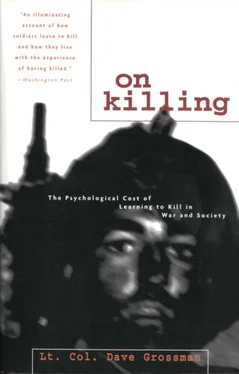In statistical terms, an increase in the aggressive predisposition of 8 percent of the population is very small. Anything less than 5 percent is not even considered to be statistically significant. But in human terms, the impact of doubling the homicide rate is enormous. Canterwall concludes:
The evidence indicates that if, hypothetically, television technology had never been developed, there would today be 10,000 fewer homicides each year in the United States, 70,000 fewer rapes, and 700,000 fewer injurious assaults. Violent crime would be half what it is.
The evidence is quite simply overwhelming. The American Psychological Association’s commission on violence and youth concluded in 1993 that “there is absolutely no doubt that higher levels of viewing violence on television are correlated with increased acceptance of aggressive attitudes and increased aggressive behavior.”
Ultimately, in the face of all this evidence, the deglamorization and condemnation of violence in the media are inevitable. It will be done in simple self-defense as our society rises up against the enabling of the violent crimes that are destroying our lives, our cities, and our civilization. When it occurs this process will probably be similar to the deglamorization of drugs and tobacco that has occurred in recent years, and for much the same reasons.
Throughout history nations, corporations, and individuals have used noble-sounding concepts such as states’ rights, lebensraum, free-market economics, and First or Second Amendment rights to mask their actions, but ultimately what they are doing is for their own personal gain and the result — intentional or not — is killing innocent men, women, and children. They participate in a diffusion of responsibility by referring to themselves as “the tobacco industry” or “the entertainment industry,” and we permit it, but they are ultimately individuals making individual moral decisions to participate in the destruction of their fellow citizens.
The ever-ascending tide of violence in our society must be stopped. Each act of violence breeds ever-greater levels of violence, and at some point the genie can never be put back in the bottle. The study of killing in combat teaches us that soldiers who have had friends or relatives injured or killed in combat are much more likely to kill and commit war crimes. Each individual who is injured or killed by criminal violence becomes a focal point for further violence on the part of their friends and family. Every destructive act gnaws away at the restraint of other men. Each act of violence eats away at the fabric of our society like a cancer, spreading and reproducing itself in ever-expanding cycles of horror and destruction. The genie of violence cannot really ever be stuffed back into the bottle. It can only be cut off here and now, and then the slow process of healing and resensitization can begin.
It can be done. It has been done in the past. As Richard Heckler observes, there is a precedent for limiting violence-enabling technology. It started with the classical Greeks, who for four centuries refused to implement the bow and arrow even after being introduced to it in a most unpleasant way by Persian archers.
In Giving Up the Gun, Noel Perrin tells how the Japanese banned firearms after their introduction by the Portuguese in the 1500s. The Japanese quickly recognized that the military use of gunpowder threatened the very fabric of their society and culture, and they moved aggressively to defend their way of life. The feuding Japanese warlords destroyed all existing weapons and made the production or import of any new guns punishable by death. Three centuries later, when Commodore Perry forced the Japanese to open their ports, they did not even have the technology to make firearms. Similarly, the Chinese invented gunpowder but elected not to use it in warfare.
But the most encouraging examples of restraining killing technology have all occurred in this century. After the tragic experience of using poisonous gases in World War I the world has generally rejected their use ever since. The atmospheric nuclear test ban treaty continues after almost three decades, the ban on the deployment of antisatellite weapons is still going strong after two decades, and the United States and the former USSR have been steadily reducing the quantity of nuclear weapons for over a decade. As we have de-escalated instruments of mass destruction, so too can we de-escalate instruments of mass desensitization.
Heckler points out that there has been “an almost unnoticed series of precedents for reducing military technology on moral grounds,” precedents that show the way for understanding that we do have a choice about how we think about war, about killing, and about the value of human life in our society. In recent years we have exercised the choice to move ourselves from the brink of nuclear destruction. In the same way, our society can move away from the technology that enables killing. Education and understanding are the first step. The end result may be that we will come through these dark years as a healthier, more self-aware society.
To fail to do this leaves us with only two possible results: to go the route of the Mongols and the Third Reich, or the route of Lebanon and Yugoslavia. No other result is possible if successive generations continue to grow up with greater and greater desensitization to the suffering of their fellow human beings. We must put the safety catch back on our society.
We have to understand, as we have never understood before, why it is that men fight and kill and, equally important, why it is that they will not. Only on the basis of understanding human behavior can we hope to influence it. The essence of this book has been that there is a force within man that will cause men to rebel against killing even at the risk of their own lives. That force has existed in man throughout recorded history, and military history can be interpreted as a record of society’s attempt to force its members to overcome their resistance in order to kill more effectively in battle.
But that force for life, Freud’s Eros, is balanced by the Thanatos, the death force. And we have seen how pervasive and consistent has been the battle between these two forces throughout history.
We have learned how to enable the Thanatos. We know how to take the psychological safety catch off of human beings almost as easily as you would switch a weapon from “safe” to “fire.” We must understand where and what that psychological safety catch is, how it works, and how to put it back on. That is the purpose of killology, and that has been the purpose of this book.
Appel, J. W., and G. W. Beebe. Aug. 18, 1946. Preventive psychiatry: an epidemiological approach. Journal of the American Medical Association 131, 1469-75.
Ardant du Picq, C. 1946. Battle studies. Harrisburg, Pa.: Telegraph Press.
Aurelius, M. 1964. Meditations. Trans. M. Staniforth. New York: Viking Penguin Books. (Original work completed 180.)
Bartlett, F. C. 1937. Psychology and the soldier. Cambridge: Cambridge University Press.
Berkun, M. 1958. Inferred correlation between combat performance and some field laboratory stresses. Research Memo (Fighter II). Arlington, Va.: Human Resources Research Office.
Bettleheim, B. 1960. The informed heart. New York.
Blackburn, A. B., W. E. O’Connell, and B. W. Richman. 1984. Post-traumatic stress disorder, the Vietnam veteran, and Adlerian natural high therapy. Individual Psychology: Journal of Adlerian Theory, Research & Practice 40 (3), 317-32.
Bolte, C. G. 1945. The new veteran. New York: Reynal and Hitchcock.
Читать дальше







